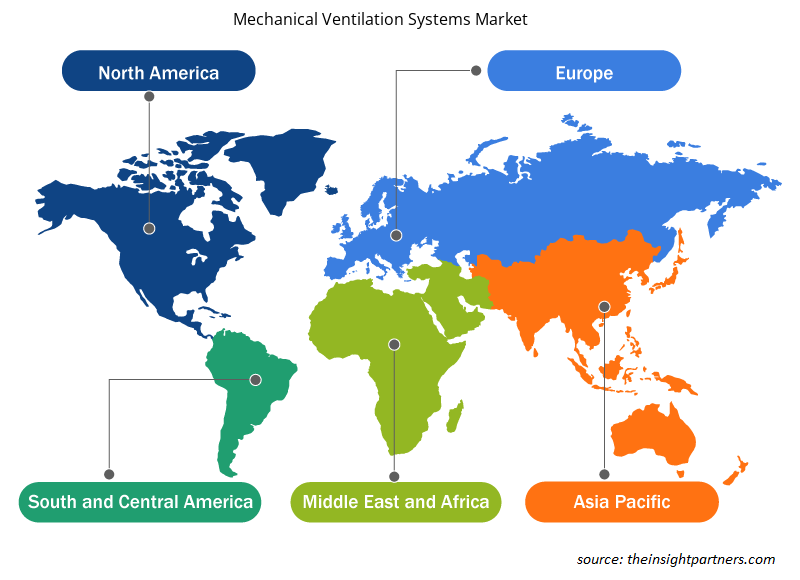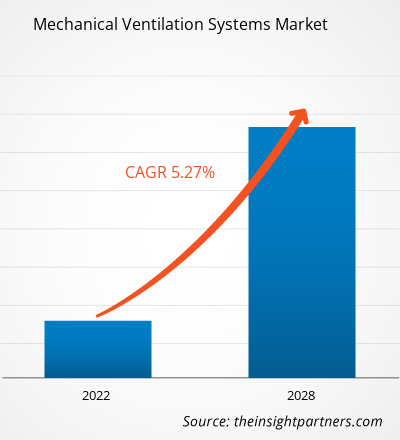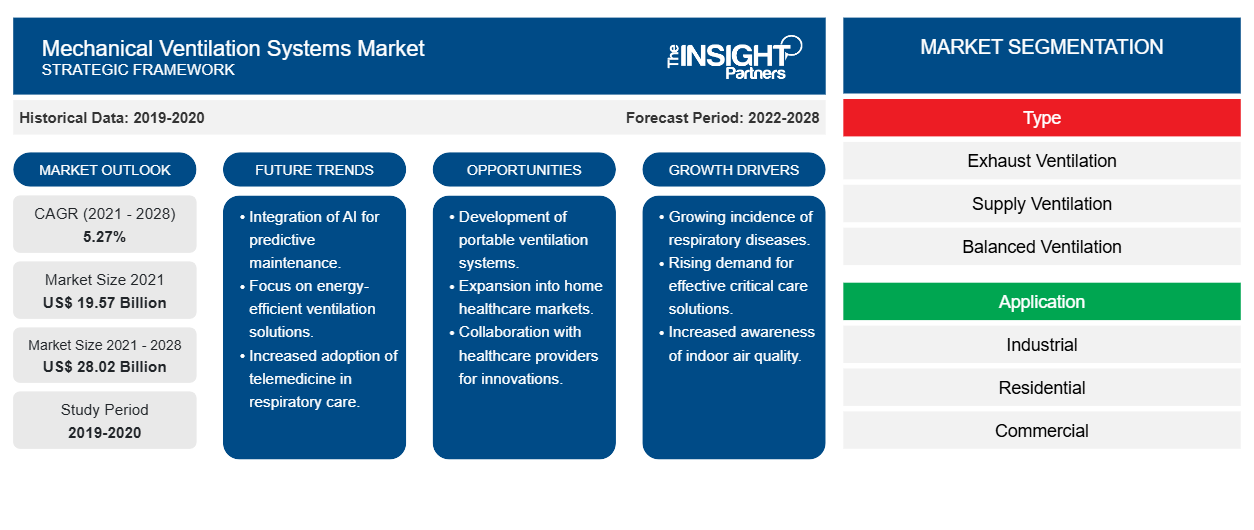Der Markt für mechanische Belüftungssysteme soll von 19.566,67 Millionen US-Dollar im Jahr 2021 auf 28.022,63 Millionen US-Dollar im Jahr 2028 wachsen; von 2021 bis 2028 wird mit einer durchschnittlichen jährlichen Wachstumsrate von 5,27 % gerechnet.
Mechanische Belüftung ist ein System, das verunreinigte Innenluft entfernt und frische Außenluft zugeführt wird, um in Wohn-, Geschäfts- und Industriebereichen eine gesunde und sichere Arbeitsumgebung zu schaffen. Ein mechanisches Belüftungssystem besteht aus zwei Hauptkomponenten – einem Frischluftzufuhrsystem und einem Abluftsystem. Das Zuluftsystem umfasst einen Lufteinlass, eine Luftfilteranlage und eine Klimaanlage. Mechanische Belüftungssysteme sind so konzipiert, dass sie Außenluft mit einer bestimmten Geschwindigkeit einführen, die der Art der Arbeit und der Menge der in einem Gebäude oder Arbeitsplatz freigesetzten Schadstoffe entspricht. Mechanische Belüftung wird bevorzugt, um die Belastung der Mitarbeiter durch Luftschadstoffe zu kontrollieren. Weitere Vorteile der mechanischen Belüftung sind die Aufrechterhaltung einer angenehmen Temperatur und Luftfeuchtigkeit sowie die Verringerung potenzieller Brand- oder Explosionsgefahren. In Wohngebäuden verwendet das Ganzhausbelüftungssystem Ventilatoren, um die Luftqualität zu verbessern, indem die Menge der Luftschadstoffe reduziert und die Luftfeuchtigkeit im Haus reguliert wird.
Passen Sie diesen Bericht Ihren Anforderungen an
Sie erhalten kostenlos individuelle Anpassungen an jedem Bericht, einschließlich Teilen dieses Berichts oder einer Analyse auf Länderebene, eines Excel-Datenpakets sowie tolle Angebote und Rabatte für Start-ups und Universitäten.
-
Holen Sie sich die wichtigsten Markttrends aus diesem Bericht.Dieses KOSTENLOSE Beispiel umfasst eine Datenanalyse von Markttrends bis hin zu Schätzungen und Prognosen.
Auswirkungen der COVID-19-Pandemie auf den Markt für mechanische Lüftungssysteme
Der COVID-19-Ausbruch hat die Weltwirtschaft durch die umfassenden Lockdowns, die die Menschen dazu zwangen, zu Hause zu bleiben, erheblich beeinträchtigt. Die Pandemie hat die Bau- und Fertigungsaktivitäten in vielen Regionen behindert, da die Verfügbarkeit von Arbeitskräften und die Versorgung mit Ausrüstung drastisch reduziert sind, was wiederum das Wachstum des Marktes für mechanische Lüftungssysteme behindert . Einige führende Anbieter des Marktes für mechanische Lüftungssysteme wie Mitsubishi Electric Corporation, Airflow Developments Limited und Infineon Technologies AG tragen jedoch erheblich zum Marktwachstum bei, indem sie strategische Kooperationen eingehen, neue Produkte auf den Markt bringen und den technologischen Fortschritt finanzieren. Lüftungssysteme helfen, luftgetragene Schadstoffe wie Viren in einem Gebäude oder kleinen Raum zu reduzieren. Das Design eines Gebäudes, die Belegung und die Art der HLK-Systeme können die Verbreitung potenzieller luftgetragener Viren und Bakterien kontrollieren. Außerdem wird erwartet, dass Modifikationen an HLK-Systemen dazu beitragen, die Verbreitung des neuartigen Coronavirus, das COVID-19 verursacht, durch Reinigung und Steuerung der Luftströme zu verringern. Die Umweltschutzbehörde empfiehlt Belüftung und Luftfilterung als wichtige Komponenten, um das Risiko der Übertragung schädlicher Luftschadstoffe auszuschließen. Es wird erwartet, dass solche Initiativen das Wachstum des Marktes für mechanische Belüftungssysteme in der Zeit nach der COVID-19-Pandemie ankurbeln werden.
Markteinblicke in mechanische Belüftungssysteme
Steigende Nachfrage nach Smart Cities weltweit
Das Wachstum von Smart Cities und Green Building-Initiativen auf der ganzen Welt treibt den Markt für mechanische Belüftungssysteme an. Strenge staatliche Vorschriften zur Reduzierung des Energieverbrauchs und erhöhte Anforderungen an nachhaltige Bauoptionen haben zum Bau von grünen Gebäuden geführt. Die zunehmende Betonung der Innenraumqualität (IEQ) in grünen Gebäuden führt zu einer Zunahme der Installationen mechanischer Belüftungssysteme. Unter den Bauherren von grünen Gebäuden besteht eine wachsende Nachfrage nach Energierückgewinnungslüftung, Ganzhausventilatoren und energiesparenden Abluftventilatoren, um Belüftung, Feuchtigkeitskontrolle und lokale Abluft, Zuluftfilterung, Radonschutz und Schadstoffkontrolle zu gewährleisten. Länder wie die USA, Kanada, Südkorea, Schweden, Taiwan, Japan, Schottland und Singapur verfolgen aktiv eine Smart City-Strategie. Die Ryerson University in Toronto, Kanada, untersucht die wirtschaftlichen Auswirkungen mechanischer Belüftung in Gebäuden, um Kohlenstoffemissionen auszugleichen und sie CO2-neutral zu machen.
Die indische Regierung startete 2015 die National Smart Cities Mission mit dem Ziel, Städte durch den Einsatz intelligenter Technologien bürgerfreundlicher und nachhaltiger zu machen. Das Indian Green Building Council (IGBC) zertifizierte grüne Gebäude mit intelligenten Belüftungssystemen, die im Vergleich zu konventionellen Gebäuden Energieeinsparungen von 40–50 % ermöglichen. Die Europäische Kommission finanziert die Smart Cities-Projekte über das Forschungs- und Innovationsprogramm Horizont 2020. Das Smart City-Programm von Dublin ermöglicht es regionalen Behörden, mit Anbietern intelligenter Technologien zusammenzuarbeiten, um das Leben in der Stadt zu verbessern. In ähnlicher Weise wandelt sich Singapur zu einer „Smart Nation“, indem es energieeffiziente Technologien zur Verbesserung des Lebens und zur Schaffung wirtschaftlicher Möglichkeiten nutzt. Laut dem US Green Building Council (USGBC) können grüne Gebäude mit unterstützenden mechanischen und Energieventilatoren zu einer Wertsteigerung von 10 % führen. Solche Initiativen haben den Bau weiterer „grüner Gebäude“ gefördert und in der Folge die Nachfrage nach mechanischen Belüftungssystemen erhöht, was das Marktwachstum erheblich vorantreibt.
Anwendungsbasierte Markteinblicke
Nach Anwendung ist der Markt für mechanische Belüftungssysteme in Industrie, Wohnbereich und Gewerbe unterteilt. Die industriellen Belüftungssysteme bestehen aus zwei zentralen Komponenten – Frischluftzufuhrsystem und Abluftsystem. Das Zuluftsystem besteht aus Komponenten wie Lufteinlass, Luftfilterausrüstung, Kanalsystemen, Ventilatoren, Heiz- und Kühlausrüstung und Luftverteilungsregistern. Es gibt zwei Arten von Belüftungssystemen für industrielle Anwendungen, nämlich Verdünnungsbelüftung und lokale Abluftsysteme. Die industrielle Umgebung umfasst künstliche Wärme- und Kälteumgebungen innerhalb einer Anlage. Sie umfasst auch die Arbeiter und Angestellten des Unternehmens innerhalb der Industrieanlage. In einer solchen Umgebung wird die Sicherheit der Mitarbeiter zu einem wichtigen Faktor für alle Industriellen. Angesichts der Bedenken hinsichtlich der Gesundheit und Sicherheit der Angestellten und Arbeiter werden daher Belüftungssysteme installiert, um eine gesündere Umgebung innerhalb einer Industrieanlage aufrechtzuerhalten. Dies ist einer der Hauptfaktoren, die das Wachstum des Marktes für mechanische Belüftungssysteme für das Industriesegment vorantreiben.
Akteure auf dem Markt für mechanische Lüftungssysteme verfolgen Strategien wie Fusionen, Übernahmen und Marktinitiativen, um ihre Position auf dem Markt zu behaupten. Nachfolgend sind einige Entwicklungen der wichtigsten Akteure aufgeführt:
- Im Juli 2021 wurde DUCO als Anbieter innovativer und hochwertiger Lösungen identifiziert, die dem Endverbraucher ein gesundes Raumklima gewährleisten. Dies wird durch das umfangreiche Sortiment des Unternehmens an Fensterlüftern und -kästen, Lamellengittern und Sonnenschutzgeweben erreicht. Für die internationale Expansion arbeitet das Unternehmen mit Daikin Europe, einem Hersteller von HVAC-Bauprodukten, zusammen.
- Im September 2021 wurde Energy Recovery Industries, ein bedeutender Hersteller und Anbieter von kohlenstoffarmen, energieeffizienten Wärmetauscherzellen, von der Volution Group Plc übernommen. Auf schuldenfreier, bargeldfreier Basis betrug der anfängliche Kaufpreis 27,2 Millionen US-Dollar, mit einer bedingten Barzahlung von bis zu 14,4 Millionen US-Dollar, abhängig von der Erfüllung der Erwartungen hinsichtlich der Finanzergebnisse für das am 31. Dezember 2023 endende Geschäftsjahr.exchanger cells, was acquired by Volution Group Plc. On a debt-free cash-free basis, the initial consideration for the acquisition was US$ 27.2 million, with a contingent cash payment of up to US$ 14.4 million based on achieving expectations for the financial results for the year ending December 31, 2023.
Regionale Einblicke in den Markt für mechanische Lüftungssysteme
Die regionalen Trends und Faktoren, die den Markt für mechanische Lüftungssysteme im Prognosezeitraum beeinflussen, wurden von den Analysten von Insight Partners ausführlich erläutert. In diesem Abschnitt werden auch die Marktsegmente und die Geografie für mechanische Lüftungssysteme in Nordamerika, Europa, im asiatisch-pazifischen Raum, im Nahen Osten und Afrika sowie in Süd- und Mittelamerika erörtert.

- Erhalten Sie regionale Daten zum Markt für mechanische Lüftungssysteme
Umfang des Marktberichts über mechanische Lüftungssysteme
| Berichtsattribut | Details |
|---|---|
| Marktgröße im Jahr 2021 | 19,57 Milliarden US-Dollar |
| Marktgröße bis 2028 | 28,02 Milliarden US-Dollar |
| Globale CAGR (2021 - 2028) | 5,27 % |
| Historische Daten | 2019-2020 |
| Prognosezeitraum | 2022–2028 |
| Abgedeckte Segmente |
Nach Typ
|
| Abgedeckte Regionen und Länder |
Nordamerika
|
| Marktführer und wichtige Unternehmensprofile |
|
Marktteilnehmerdichte: Der Einfluss auf die Geschäftsdynamik
Der Markt für mechanische Lüftungssysteme wächst rasant, angetrieben durch die steigende Nachfrage der Endnutzer aufgrund von Faktoren wie sich entwickelnden Verbraucherpräferenzen, technologischen Fortschritten und einem größeren Bewusstsein für die Vorteile des Produkts. Mit steigender Nachfrage erweitern Unternehmen ihr Angebot, entwickeln Innovationen, um die Bedürfnisse der Verbraucher zu erfüllen, und nutzen neue Trends, was das Marktwachstum weiter ankurbelt.
Die Marktteilnehmerdichte bezieht sich auf die Verteilung der Firmen oder Unternehmen, die in einem bestimmten Markt oder einer bestimmten Branche tätig sind. Sie gibt an, wie viele Wettbewerber (Marktteilnehmer) in einem bestimmten Marktraum im Verhältnis zu seiner Größe oder seinem gesamten Marktwert präsent sind.
Die wichtigsten auf dem Markt für mechanische Belüftungssysteme tätigen Unternehmen sind:
- Volution Group Ltd.
- Aremec
- Mechanische Luftversorgungen GmbH
- Duco Lüftung und Sonnenschutz
- Caladair International
Haftungsausschluss : Die oben aufgeführten Unternehmen sind nicht in einer bestimmten Reihenfolge aufgeführt.

- Überblick über die wichtigsten Akteure auf dem Markt für mechanische Lüftungssysteme
Der globale Markt für mechanische Lüftungssysteme wurde wie folgt segmentiert:
Markt für mechanische Lüftungssysteme – nach Typ
- Abluftventilation
- Belüftungsversorgung
- Ausgewogene Belüftung
- Lüftung mit Energierückgewinnung
Markt für mechanische Lüftungssysteme – nach Anwendung
- Industrie
- Wohnen
- Kommerziell
Markt für mechanische Lüftungssysteme – nach Geografie
-
Nordamerika
- UNS
- Kanada
- Mexiko
-
Europa
- Deutschland
- Frankreich
- Italien
- Vereinigtes Königreich
- Russland
- Restliches Europa
-
Asien-Pazifik (APAC)
- Australien
- China
- Indien
- Japan
- Südkorea
- Restlicher Asien-Pazifik-Raum
-
Naher Osten und Afrika (MEA)
- Südafrika
- Saudi-Arabien
- Vereinigte Arabische Emirate
- Rest von MEA
-
Südamerika (SAM)
- Brasilien
- Argentinien
- Rest von SAM
Firmenprofile
- Volution Group plc
- DUCO Lüftung & Sonnenschutz
- Caladair International
- Mitsubishi Electric Corporation
- Airflow Developments Limited
- Wirbel
- BLAUBERG
- INFINEON TECHNOLOGIES AG
- AERMEC (Großbritannien)
- MECHANICAL AIR SUPPLIES LTD
- Historische Analyse (2 Jahre), Basisjahr, Prognose (7 Jahre) mit CAGR
- PEST- und SWOT-Analyse
- Marktgröße Wert/Volumen – Global, Regional, Land
- Branchen- und Wettbewerbslandschaft
- Excel-Datensatz
Aktuelle Berichte
Erfahrungsberichte
Grund zum Kauf
- Fundierte Entscheidungsfindung
- Marktdynamik verstehen
- Wettbewerbsanalyse
- Kundeneinblicke
- Marktprognosen
- Risikominimierung
- Strategische Planung
- Investitionsbegründung
- Identifizierung neuer Märkte
- Verbesserung von Marketingstrategien
- Steigerung der Betriebseffizienz
- Anpassung an regulatorische Trends























 Kostenlose Probe anfordern für - Markt für mechanische Lüftungssysteme
Kostenlose Probe anfordern für - Markt für mechanische Lüftungssysteme